RBSE Solutions for Class 8 Science Chapter 6 Reproduction in Plants are part of RBSE Solutions for Class 8 Science. Here we have given RBSE Rajasthan Board Solutions for Class 8 Science Chapter 6 Reproduction in Plants.
Rajasthan Board Solutions for Class 8 Science Chapter 6 Reproduction in Plants
| Board | RBSE |
| Class | Class 8 |
| Subject | Science |
| Chapter | Chapter 6 |
| Chapter Name | Reproduction in Plants |
| Number of Questions Solved | 50 |
| Category | RBSE Solutions |
Reproduction in Plants Textbook Questions Solved
I. Multiple Choice Questions
Question 1.
- Vegetative reproduction is found in
(a) Potato
(b) Wheat
(c) Neem
(d) Pea - Fusion of male and female gametes is called
(a) Pollination
(b) Fertilization
(c) Budding
(d) Spore - Unisexual flower is
(a) Maize
(b) Mustard
(c) Rose
(d) Petunia - Bisexual flower is
(a) Papaya
(b) Maize
(c) Cucumber
(d) Mustard
Answers:
- (a)
- (b)
- (a)
- (d)
Question 2.
Fill in the blanks:
- Fern and moss reproduce by……………..
- To produce……………..of their own kind is called……………..
- ……………..is formed by the fusion of male and female gametes.
- In……………pollens from the anthers reaches the stigma of the same flower.
Answers:
- asexual reproduction
- individuals, reproduction
- Zygote
- flower
Question 3.
Match the column A with column B:
| Column A | Column B |
| 1. Fragmentation | 1. Mustard |
| 2. Budding | 2. Banana |
| 3. Parthenogenesis | 3. Yeast |
| 4. Sexual reproduction | 4. Spirogyra |
Answer:
| Column A | Column B |
| 1. Fragmentation | 1. Spirogyra |
| 2. Budding | 2. Yeast |
| 3. Parthenogenesis | 3. Banana |
| 4. Sexual reproduction | 4. Mustard |
Reproduction in Plants Short Answer Type Questions
Question 1.
Describe the various processes of asexual reproduction. Give example of each.
Answer:
Asexual reproduction takes place in the following methods:
(a) Budding:
Put a pinch of yeast in a beaker containing water, now put a spoon of sugar into it and shake properly. Keep it at warm place after an hour when a drop of this solution is kept on a slide and seen with a microscope, cells of new yeast would be seen. Cell of yeast form a bud, it grows and detach from parent cell and grows into new cell.
(b) Fragmentation:
You might have seen green slippery substance in ponds or stagnant water, it is called algae. They rapidly grow through fragmentation, example: Spirogyra.
(c) Spore formation:
lf the pieces of bread are kept in moisture, then after some time cotton web like fungi are developed. It contains black brown spores. When these spores become free they float in air as they are light in weight spread upto a great distance. Every spore due to adverse conditions like high temperature and moisture forms a hard coat around it. When favourable conditions come it sprouts and develop into new fungi tentacles like mucor and rhizopus. Such reproduction generally occurs in lower organisms like – algae, fungi, mosses, and fern.
Question 2.
Differentiate between unisexual and bisexual flower.
Answer:
In flowering plants, flowers are the reproductive organs. Some flower like rose and sweet pea contain both male and female reproductive organs. They are hermaphrodites and are known as complete (or bisexual) flowers. Complete flower have stamens, pistil, petals and sepals. Other flowers like com and papaya contain only male or female reproductive organ. They are known as incomplete (or unisexual) flower.
Question 3.
Differentiate between Self pollination and Cross pollination.
Answer:
| Self pollination | Cross pollination |
| Transfer of pollens from the anther to the stigma of the same flower or to the stigma of another flower of the same plant is called self pollination. Example: Pea, tomato, cucumber. |
Transfer of pollens from the anther to the stigma of flower of another plant of same species is called cross pollination. Example: Rose, poppy. |
Question 4.
Draw a labelled diagram of a flower.
Answer:
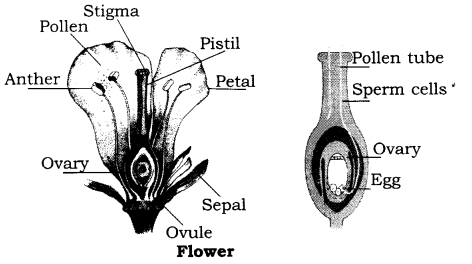
Question 5.
Explain parthenocarpy with an example.
Answer:
When the ovary directly develops into fruit without fertilization, this is called parthenocarpy. Fruits develop in such a way that they do not contain seed. Example: banana, grapes etc.
Question 6.
Write the three laws of inheritance given by Mendel.
Answer:
Mendel’s three laws of inheritance are as follows:
- Law of Dominance
- Law of Segregation
- Law of Independent Assortment.
Reproduction in Plants Long Answer Type Questions
Question 1.
Differentiate between Sexual and Asexual reproduction.
Answer:
| Sexual reproduction | Asexual reproduction |
| (i) It involves formation and fusion of gametes. | It does not involve formation and fusion of gametes. |
| (ii) Two parents are required | Only one parent is required |
| (iii) Off springs show variations.They differ from either of their parents. |
Offspring are genetically identical to parents. |
| (iv) It includes mitosis as well as meiosis | It includes mitosis only. |
| (v) Leads to more genetic variability. | Leads to less variability |
| (vi) It is shown by higher organisms. | Generally shown by simple organisms. |
Question 2.
Explain process of sexual reproduction with diagram.
Answer:
Sexual reproduction in Plants: In plant kingdom the flowering plants are the most highly advanced plants. Flower bears the sex organs of a plant. In some plants male and female sex organs are present in the same plant. Such plants are called bisexual or hermaphrodite. When male and female sex organs are present in different plants, such plants are unisexual. We can learn the process of sexual reproduction easily in the flower of madar (Aak) or Datura. The swollen apical end of pedicel of flower is called thalamus or receptacle. The four whorls of flower namely calyx, corolla, androecium and gynoecium are inserted on thalamus.
Androecium and gynoecium are called as reproductive whorls and calyx and corolla as accessory whorls or supporting whorls. Sepals the members of calyx whorl are generally green and petals, the members of corolla whorl .are coloured and attractive. Stamen, the member of androecium, is a stalk like structure with flattened top, the anther or pollen sacs. In anther the male generative cells give rise to pollen grains. Each pollen grain divides to form two male gametes. The carpel which is the female organ and a member of gynoecium whorl has three parts. Basal swollen part is ovary which encloses the ovules. Each ovule contains one female gamete-egg. A long, tubular structure is developed above the ovary called as style. The top flat end of style is stigma.
Question 3.
Explain the various processes of vegetative reproduction with examples.
Answer:
Various processes of vegetative reproduction are:
1. Cutting:
It is a vegetative propagation technique in which a portion of the plants containing leaf buds is cut from the parent plant. It is then induced to form roots and shoots by providing a favourable environment like moist soil with sufficient nutrients.
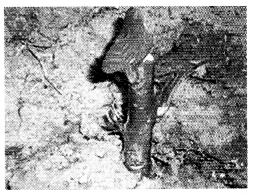
It is a beneficial method as many new plants can be obtained from a single plant in lesser time. A number of plants including banana, pineapple rose, bougainvilla, sugarcane and cactus can be propagated by using cuttings.
2. Grafting:
Grafting is a method of plant propagation where parts of one plant are fused with another plant.
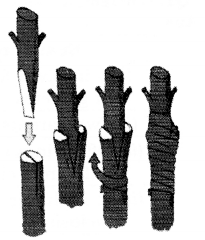
One plant is selected for its roots, and this is called the stock. The other plant is selected for its stems, leaves, flowers or fruits and is called the scion. The scion gets essential nutrients from the stock. The resultant plant possesses the features of both the grafted plants. Grafting helps in producing delicious varieties of mangoes and apples.
3. Layering:
It involves plants with long, flexible branches where a branch of stem still attached to the parent plant. It is placed in contact with moist soil, encouraging it to send out roots. Once the roots emerge, new plantlets are formed. These can be separated from the parent plant and grow as new individual plants. Grapes, Rasberry and Jasmine can be easily propagated by layering.
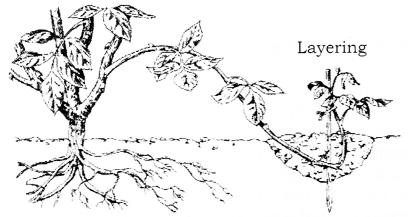
4. Tissue culture:
Plant tissues have the ability to generate whole new plants.Leaving and actively multiplying tissue is obtained from the plant and is kept in a medium containing appropriate amount of nutrients.
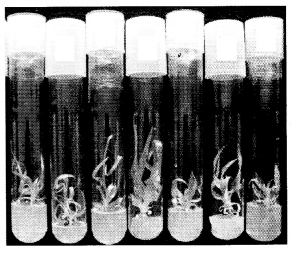
It is then treated with root and shoot including chemicals in the laboratory. Once it develops into a plantlet, it can be transplanted into soil in the nursery and raised into a full-grown plants. Orchids, bananas, and chrysanthemums are grown by using tissue culture.
Reproduction in Plants Additional Questions Solved
I. Multiple Choice Questions
Question 1.
Which of the following methods of reproduction is sexual?
(a) vegetative reproduction
(b) spore formation
(c) budding
(d) none of these
Question 2.
Yeast reproduce by:
(a) budding
(b) sexual reproduction
(c) vegetative reproduction
(d) spore formation
Question 3.
Potatoes propagate through:
(a) grafting
(b) layering
(c) tissue culture
(d) vegetative propagation
Question 4.
An ovary of a flower may contain one or more:
(a) pollen grains
(b) ovules
(c) both (a) and (b)
(d) none of these
Question 5.
Which of these is the male reproductive organ in plants?
(a) pistil
(b) pollen grain
(c) stamen
(d) ovule
Question 6.
After fertilization, which part of the flower converts into fruit?
(a) male gamete
(b) ovules
(c) ovary
(d) parent
Question 7.
Endosperm in angiosperms is:
(a) trimultiple
(b) dimultiple
(c) multiple
(d) none of these
Question 8.
The mode of reproduction connected with the fazzy, greyish growth on bread is-
(a) budding
(b) spore formation
(c) binary fission
(d) vegetative reproduction
Question 9.
The migration of pollen grains to stigma is called as
(a) fertilization
(b) fusion
(c) pollination
(d) reproduction
Question 10.
Father of heredity is:
(a) Mendel
(b) Butler
(c) Aristotle
(d) Darwin
Question 11 .
How many Laws of heredity are there?
(a) 1
(b) 2
(c) 3
(d) 4
Question 12.
Seed dispersal take place by
(a) wind
(b) water
(c) animals
(d) all of the above
Answers:
1. (b)
2. (a)
3. (d)
4. (b)
5. (c)
6. (e)
7. (a)
8. (c)
9. (c)
10. (a)
11. (c)
12. (d)
Reproduction in Plants Very Short Answer Type Questions
Question 1.
What is reproduction?
Answer:
Reproduction is the process of producing new individuals of the same kind.
Question 2.
Write the two examples of a sexual reproduction?
Answer:
Fragmentation and vegetative reproduction are examples of a sexual reproduction.
Question 3.
Define cutting process. How does a new plant produce?
Answer:
In this process, the stem of plant is cut diagonally and put in the soil. After sometime roots will grow in that cutting and new plant is grown. This process is known as cutting.
Question 4.
Name the largest and smallest flower?
Answer:
Largest flower – Rafflesia
Smallest flower – Wolffia
Question 5.
Where do the asexual and vegetative reproduction takes place?
Answer:
Vegetative and asexual reproduction takes place in lower classes of plants.
Question 6.
Where does sexual reproduction takes place?
Answer:
Sexual reproduction takes place in higher classes of plants in which male and female gametes fuse.
Question 7.
Define heredity.
Answer:
The process of transfer of hereditary characters from one generation to another generation is called heredity.
Question 8.
Who is known as the father of genetics?
Answer:
Sir Gregor John Mendel is known as the father of genetics.
Question 9.
Name the vegetative parts of plants.
Answer:
Stem and leaves
Question 10.
Give example of bisexual and unisexual flower.
Answer:
Bisexual – mustard and rose.
Unisexual – cucumber, maize and watermelon.
Reproduction in Plants Short Answer Type Questions
Question 1.
What is fertilization? Name the cell formed as product of fertilization.
Answer:
The process of fusion of male nucleus and female nucleus is called fertilization. Fertilization results in the diploid zygote.
Question 2.
How does new plant grow from the leaves?
Answer:
Leaves of some plants like bryophyllum have buds in the margins of leaves. If a leaf of such plant falls on moist soil, each bud can give rise to a new plant.
Question 3.
Why reproduction is necessary?
Answer:
By reproduction the continuity of biological species is maintained right from the time of their origin. Though like respiration and excretion, reproduction is not essential for the life of an individual but is necessary for the existence and continuity of species in universe.
Question 4.
How do fungi and fern reproduce to give rise to new plants?
Answer:
Fungi and fern plants grow by the process of spore formation. The spores are asexual reproductive bodies. Each spore is covered by a hard protective coat to withstand unfavourable conditions such as high temperature and low humidity. Under the favourable conditions spores germinate and develop into new individuals.
Question 5.
Explain the process of spore formation?
Answer:
Sporogenesis for spore formation- This is the most common method of asexual reproduction in the majority of fungi. In this method a structure called as sporangium (plural = sporangia) is developed from the fungal hypha. The nucleus of sporangium dissects several times into many daughter nuclei. Each daughter nucleus gethers a bit of cytoplasm all around and develops into a spore. The sporangium dehisces after the maturation of spores liberating the spores. The spores germinate and develop into new hypha after reaching the ground or substratum. Example – rhizopus.
Question 6.
Fruits are divided into how many classes? Explain.
Answer:
Fruit may be classified into three major groups
- Simple fruits: Simple fruits develop from a single matured ovary in a single flower. Accessory fruits have some other flower part united with the ovary.
Example: Mango, Wheat, etc. - Aggregate fruits: Aggregate fruits consist of a number of matured overies formed in a single flower and arranged over the surface of a single receptacle. Individual ovaries are called fruitlets.
Example: Strawberry. - Multiple fruits: Multiple fruits consist of the matured ovaries of several to many flowers more or less united into mass. Multiple fruits are almost invariably accessory fruits.
Example: Mulberry.
Activity Based Questions
Activity 1.
Question 1.
What are scars of a potato called? How do these help the potato?
Answer:
Scars on the potato are called its eyes. New potato plants grow from these eyes.
Activity 2.
Question 1.
Which plant is propagated through stem cutting?
Answer:
Rose plant is propagated through stem cutting.
Activity 3.
Question 1.
What happens to the series of buds in yeast?
Answer:
They detach from parent yeast and grow individually.
Question 2.
What are spores look like?
Answer:
The spores look like mesh cotton.
Activity 4.
Question 1.
Find out the different parts of Datura flower.
Answer:
Draw them as a chart.
Question 2.
What do you mean by true fruit and false fruit?
Answer:
If only ovary of the flower takes part in formation of fruit then it is called true fruit such as mango. Other than ovary, if petals, pistils of the flower take part* in formation of fruit, then it is called false fruit such as apple.
Question 3.
Write the importance of vegetative reproduction.
Answer:
Importance of vegetative reproduction:
- Vegetative reproduction is the only method to maintain and multiply the desired varieties at commercial level, of those plants which are naturally non-seed-producing that is seeds are not produced in them. For example banana, sugarcane, rose etc. and seedless varieties of grapes and orange etc.
- Sufficient time is required in the production of flowers in those plants which are produced by the germination of seeds. Further the the development of a plant from seed is not always definite. On the contrary the development of a plant by vegetative propagation is definite and the time required for flowering and fruiting is very small.
- The new plants produced by vegetative propagation are exactly similar in characters to that of mother plant. Thereby the desired characters are maintained true generation after generation. However, the plants produced from seeds often become inferior in characters as compared to the parent plants.
- The production is high in the plants produced by vegetative propagation.
Question 4.
What is pollination? How does it lead to fertilization? Explain with the help of diagram?
Answer:
The process of transfer of pollen grains from anther to the stigma of the flower of a plant of same species is known as pollination. The fusion of male and female gametes take place only after pollination.
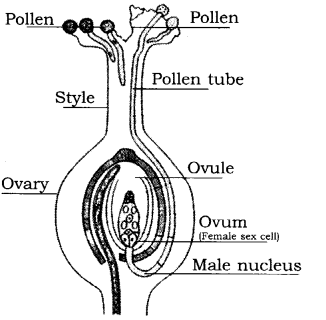
The pollen grains are deposited on the stigma by pollination. The pollen grains germinate on stigma producing a tube known as pollen tube. The pollen tube grows downward into the style and reaches to ovary. Finally it enters into the ovule through a minute pore. Here one male gamete fuses with egg. It is the act of actual fertilization by which production of zygote and development of embryo take place.
Question 5.
Explain the structure of Datura plant with diagram?
Answer:
Datura flower is a funnel shaped flower and can be seen in creamish white, pink or light violet colours.
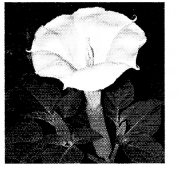
The following parts of Datura flower are given below- Floral Parts:
(a) Pedical: Small green stick-like structure, which holds the flower on the stem.
(b) Thalamus: The top of the pedical forms a flat disc-like structure. The thalamus holds all other parts of the flower on it.
(c) Calyx: The outermost cup-shaped green structure is the calyx. In this flower five green leafy sructures unite to form the cup-shaped calyx. These five leafy structures are called sepals.
(d) Corolla: The whorl of petals next to calyx is known as corolla. In Datura flower corolla may be creamish white pink or violet in colour.
Sexual Parts:
(a) Androecium or Stamen: It is the third inner whorl of a complete flower. It is composed of five stamens. Each stamens has two parts, the lower position of it is a five thread like filament and the upper position is an elongated swollen anther. In Dhatura flower the filaments remain attached to the petals but the anther remain free. Each anther has two lateral lobes joined side by side. Within anthers numerous pollen grains are stored.
(b) Gynoecium or Pistil: The innermost whorl of a complete flower is the gynoecium or pistil. The unit of gynoecium is called carpel. Datura flower has two carpels in its gymnoecium. The two carpels join together to form a long-necked pitcher-shaped structure. The swollen base of it is the ovary which holds ovules in it. The long tube-like part emerging from the ovary is called style. The apex of the style is slightly swollen and sticky, it is called stigma. Stigma catches the pollen grains during pollination.
Question 6.
Define genes. Make the list of contrasting traits of pea plant studied by Mendel.
Answer:
Mendel concluded from his experiment that the factors which is responsible for a particular structural and physiological characteristics of the organism are present in pairs which now a days called genes. Mendel performed hybridisation experiment in pea plant with reference to the following seven pairs of contrasting character.
| Plant character | Dominant character | Recessive character |
| Length of plant | Tall | Dwarf |
| Position of flowers | Axillary | Terminal |
| Form of pod | Inflated or flat | Constricted |
| Colour of unripe pod | Green | Yellow |
| Colour of seed | Round | Wrinkled |
| Shape of seedcoat | Grey | White |
| Colour of cotyledons | Yellow | Green |
We hope the given RBSE Solutions for Class 8 Science Chapter 6 Reproduction in Plants will help you. If you have any query regarding RBSE Rajasthan Board Solutions for Class 8 Science Chapter 6 Reproduction in Plants, drop a comment below and we will get back to you at the earliest.